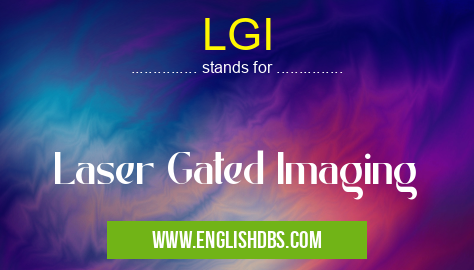What does LGI mean in PHOTOGRAPHY & IMAGING
LGI (Laser Gated Imaging) is an advanced imaging technique that utilizes pulsed lasers to capture high-resolution images in challenging lighting conditions, such as low light or intense backlighting. This technology enables the extraction of depth information and detailed surface features from objects, making it valuable in various fields.

LGI meaning in Photography & Imaging in Miscellaneous
LGI mostly used in an acronym Photography & Imaging in Category Miscellaneous that means Laser Gated Imaging
Shorthand: LGI,
Full Form: Laser Gated Imaging
For more information of "Laser Gated Imaging", see the section below.
Principle of Operation
LGI employs a synchronized laser and camera system. The laser emits short, high-energy pulses that illuminate the target scene, and the camera captures the reflected light. The laser's pulse duration is precisely controlled to enable the camera's shutter to open and close during the illumination period, effectively "freezing" the scene at the instant of laser illumination.
By capturing multiple images at different laser pulse delays, LGI can generate depth maps and 3D models of the target object. The laser's short pulse duration minimizes motion blur, while the controlled illumination enables the camera to capture images with high signal-to-noise ratios, resulting in sharp and detailed images.
Applications
LGI finds applications in a wide range of fields, including:
- Automotive: Night vision enhancement, obstacle detection, and autonomous driving systems.
- Industrial Automation: Inspection of manufactured parts, quality control, and robotic guidance.
- Medical Imaging: Tissue characterization, intraoperative navigation, and minimally invasive surgery.
- Security and Surveillance: Nighttime surveillance, facial recognition, and perimeter monitoring.
- Military Applications: Target detection, range finding, and terrain mapping.
Advantages
- High Resolution: Captures detailed images with minimal blur and noise.
- Depth Information: Generates depth maps and 3D models, providing valuable spatial data.
- Robust to Lighting Conditions: Operates effectively in both low light and intense backlighting scenarios.
- Portable and Compact: LGI systems can be miniaturized and integrated into compact devices for handheld or mobile applications.
Essential Questions and Answers on Laser Gated Imaging in "MISCELLANEOUS»PHOTOGRAPHY"
What is Laser Gated Imaging (LGI)?
Laser Gated Imaging (LGI) is a time-resolved imaging technique that uses a pulsed laser to illuminate a scene and a gated camera to capture images. The laser pulse is typically very short, on the order of nanoseconds or picoseconds, and the camera gate is synchronized to open only during a specific time interval after the laser pulse. This allows the camera to capture images of objects that are moving or changing rapidly, as only the light that is emitted or reflected during the open gate time will be recorded.
What are the applications of LGI?
LGI has a wide range of applications in various fields, including:
- Industrial inspection and quality control
- Non-destructive testing
- Biomedical imaging
- Flow visualization
- Ballistics research
What are the advantages of using LGI?
LGI offers several advantages over conventional imaging techniques, including:
- High temporal resolution: LGI can capture images with very short exposure times, allowing for the visualization of fast-moving objects or processes.
- Reduced motion blur: By synchronizing the camera gate with the laser pulse, LGI can eliminate motion blur, resulting in sharper and more detailed images.
- Enhanced signal-to-noise ratio: LGI can improve the signal-to-noise ratio by reducing the amount of ambient light that is captured by the camera.
What are the limitations of LGI?
LGI also has some limitations, including:
- Limited range: The range of LGI is limited by the power and wavelength of the laser used.
- Sensitivity to ambient light: LGI can be sensitive to ambient light, especially when imaging in bright environments.
- Cost: LGI systems can be relatively expensive to purchase and maintain.
How does LGI differ from other time-resolved imaging techniques?
LGI differs from other time-resolved imaging techniques, such as streak cameras and image intensifiers, in the way that it synchronizes the illumination and detection processes. LGI uses a pulsed laser to illuminate the scene and a gated camera to capture images, while streak cameras and image intensifiers use continuous illumination and a continuously open gate or shutter.
Final Words: LGI is an innovative imaging technology that offers high-resolution, depth-aware images in challenging lighting conditions. Its versatility and wide-ranging applications make it a valuable tool in various fields, including automotive, industrial automation, medical imaging, security, and military operations.
LGI also stands for: |
|
| All stands for LGI |
